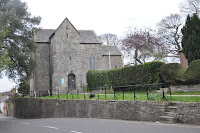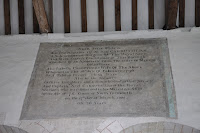I had been dying to visit St. Martin's church since the first day andwas therefore rather disappointed to realise its door was closed before four, which was not in consonance with its timetable. A small notice though referred us to the number 35 in the North street so as to get the key to the church, which we did as soon as we reached Wareham.
To our surprise the shop assistant handed us the key without any constraints, which ultimately meant we spent the amount of time we wanted and took as many photographs as we wanted to.

According to written information provided by the church warden the Church as it now stands represents the most complete example of a Saxon Church with a tall narrow nave and chancel, as well aa a late Saxon wall-arcading in the North West isle.
Its walls are covered with fragmented frescoes- 12th century figured ones in the chancel, black letter inscriptions of the 16th and 17th centuries and a bond memorial inscription of about 1800.






A number of painted red stars to be seen on one of the walls are said to have been put there during the great plague and the hardships faced by the parish in the 17th century. It is believed that every person that died there was a red star painted on the wall.

During the great fire of Wareham in 1762 the church is said to have been used as a temporary refuge for those who had lost their homes.


The 12th century frescoes on the North wall of the chancel depict Saint Martin on horseback, escorted by attendants, dividing his cloak and giving one half to a naked beggar.

The priceless effigy of T.E. Lawrence, also known as Lawrence of Arabia is one of the main reasons as to why so many visit this tiny Church - to find a tribute by a well known artist (Eric Kennington) to a man who became famous for being the only British officer on the Arab front fighting against the Turks.
The effigy is said to have been made for St. Paul's Cathedral, though the political unrest surrounding his death meant they wouldn't accept it, the same reason having led to the refusals on the part of Westminster Abbey and Salisbury Cathedral.
Because of having to put it somewhere ended up being at St. Martin's considered fitting once he had ties to Dorset because of having resided for many years in an equally tiny cottage between Dorchester and Wareham until the motorcycle accident that cause his death in 1953.



Before we left another two people walked in having thought I was the actual guardian, for the simple reason I was holding the huge key. They told us we should visit Lawrence's burial place in Moreton.
We loved the little Church and I was happy to have insisted on its visit.












No comments:
Post a Comment